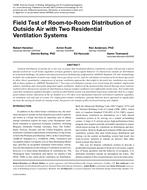
Field Test of Room-to-Room Distribution of Outside Air with Two Residential Ventilation Systems
Uniform distribution of outside air is one way to ensure that residential dilution ventilation systems will provide a known amount of fresh air to all rooms regardless of house geometry and occupant behavior. To characterize outside air distribution in residential buildings, the authors developed a practical methodology adapted from ASHRAE Standard 129. Our methodology includes the examination of multi-zone single tracer gas decay curves, and the calculation of reciprocal local mean age-of-air to allow direct, quantitative comparisons of various ventilation approaches that might be factored into ventilation rate tradeoffs in future updates to ASHRAE Standard 62.2. Two types of ventilation systems were tested using this method: single-point exhaust ventilation and central fan integrated supply ventilation. Analysis of the measured data showed that age-of-air analysis worked well to characterize outside air distribution as long as weather conditions were sufficiently steady-state. Test results indicated that ventilation supplied through a central air distribution system was distributed much more uniformly than by a singlepoint exhaust system. Operation of the air handler at a 33% duty cycle maintained relatively well-mixed conditions regardless of ventilation rate and type of system. For single-point exhaust ventilation, opening bedroom doors appeared to significantly increase the mixing of outside air among rooms, but passive air transfer grilles increased mixing only slightly.
IAQ 2007 Conference held in Baltimore, Maryland, October 14-17, 2007
Units: I-P
Citation: IAQ Conference: IAQ 2007: Healthy and Sustainable Buildings
Product Details
- Published:
- 2008
- Number of Pages:
- 13
- File Size:
- 1 file , 720 KB
- Product Code(s):
- D-IAQ2007-16


